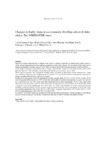Mostrar o rexistro simple do ítem
Changes in frailty status in a community-dwelling cohort of older adults: the VERISAÚDE study
| dc.contributor.author | Lorenzo-López, Laura | |
| dc.contributor.author | López-López, Rocío | |
| dc.contributor.author | Maseda, Ana | |
| dc.contributor.author | Buján, Ana | |
| dc.contributor.author | Rodríguez-Villamil, José Luis | |
| dc.contributor.author | Millán-Calenti, José Carlos | |
| dc.date.accessioned | 2018-12-11T12:42:26Z | |
| dc.date.issued | 2018-11-15 | |
| dc.identifier.citation | Lorenzo-López L, López-López R, Maseda A, Buján A, Rodríguez-Villamil JL, Millán-Calenti JC. Changes in frailty status in a community-dwelling cohort of older adults: the VERISAÚDE study. Maturitas. 2019;11:54-60 | es_ES |
| dc.identifier.issn | 0378-5122 | |
| dc.identifier.uri | http://hdl.handle.net/2183/21496 | |
| dc.description.abstract | [Abstract] Objectives: Greater understanding of changes in the degree of frailty is important for clarifying the natural history of frailty and may help clinical decision-making regarding preventive interventions. The objectives of this study were to explore natural frailty transition rates at 1-year follow-up and to identify the main determinants of such transitions. Study design: Prospective longitudinal study covering a representative sample of community-dwelling older adults aged ≥65 years (n = 749) at baseline, and transition information at 1-year follow-up (n = 537). Mean outcome measures: The assessment of frailty status was based on phenotypic criteria (unintentional weight loss, weakness, exhaustion, slow walking speed, low physical activity). Frailty transitions (progressed, regressed, no change, or death) and associated factors were assessed. Results: Most participants remained unchanged from their baseline status (57.1% non-frail, 83.4% pre-frail, 66.7% frail). Regarding frailty transitions, 42.9% of non-frail older adults at baseline had progressed to a pre-frail status by the 1-year follow-up, and 7.9% of pre-frail older adults had become frail. Importantly, 33.3% of frail older adults regressed to a pre-frail status and 8.7% of pre-frail adults had regressed to a non-frail status. Non-frail females tended to progress to pre-frailty significantly more than males (p = 0.006), and mortality was higher among participants classified as frail at baseline (10.7%). Logistic regression showed that the main determinants of worsening frailty were hearing impairment (OR 3.180; 95% CI 1.078–9.384), congestive heart failure (OR 10.864; 95% CI 1.379–85.614), and polypharmacy (OR 2.572, 95% CI 1.096–6.037). Conclusion: Our results confirm the dynamic of frailty and the bidirectional nature of frailty transitions, and indicate the need for preventing and treating these conditions in later life in order to minimize the burden of frailty. | es_ES |
| dc.description.sponsorship | This research was supported by the Xunta de Galicia project EM 2012/100: “VERISAÚDE project: Effectiveness of the Comprehensive Gerontological Assessment and longitudinal follow-up in the healthy aging promotion”, ED431C 2017/49 and FrailNet network IN607C, 2016/08. LLL is supported by the “Ramon y Cajal” Postdoctoral Senior Grant (RYC-2015-18394) from the Spanish Ministry of Economy, Industry and Competitiveness, co-financed by the European Social Fund; and by the Xunta de Galicia (project ED431F 2017/09). RLL is supported by a predoctoral grant from the Autonomous Government of Galicia (I2C programme). Funding sources had no involvement in study design, collection, analysis and interpretation of data, writing of the report, or in the decision to submit the article for publication | es_ES |
| dc.description.sponsorship | Xunta de Galicia; ED431C 2017/49 | es_ES |
| dc.description.sponsorship | Xunta de Galicia; IN607C, 2016/08 | es_ES |
| dc.description.sponsorship | Xunta de Galicia; EM 2012/10 | |
| dc.description.sponsorship | info:eu-repo/grantAgreement/MINECO/Programa Estatal de Promoción del Talento y su Empleabilidad/RYC-2015-18394/ES/ | |
| dc.description.sponsorship | Xunta de Galicia; ED431F 2017/09 | |
| dc.language.iso | eng | es_ES |
| dc.publisher | Elsevier | es_ES |
| dc.relation.uri | https://doi.org/10.1016/j.maturitas.2018.11.006 | es_ES |
| dc.rights | Creative Commons Attribution-NonCommercial-NoDerivs 4.0 International License (CC-BY-NC-ND 4.0) | es_ES |
| dc.rights.uri | http://creativecommons.org/licenses/by-nc-nd/4.0/ | * |
| dc.subject | Frailty transitions | es_ES |
| dc.subject | Pre-frailty | es_ES |
| dc.subject | Older adults | es_ES |
| dc.subject | Mortality | es_ES |
| dc.subject | Hearing impairment | es_ES |
| dc.title | Changes in frailty status in a community-dwelling cohort of older adults: the VERISAÚDE study | es_ES |
| dc.type | info:eu-repo/semantics/article | es_ES |
| dc.rights.access | info:eu-repo/semantics/embargoedAccess | es_ES |
| dc.date.embargoEndDate | 2019-11-15 | es_ES |
| dc.date.embargoLift | 2019-11-15 | |
| UDC.journalTitle | Maturitas | es_ES |
| UDC.volume | 119 | es_ES |
| UDC.startPage | 54 | es_ES |
| UDC.endPage | 60 | es_ES |
Ficheiros no ítem
Este ítem aparece na(s) seguinte(s) colección(s)
-
GI-GIGG - Artigos [115]
-
INIBIC-IX - Artigos [31]






